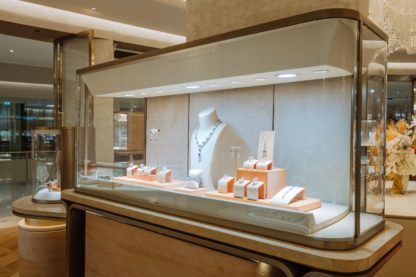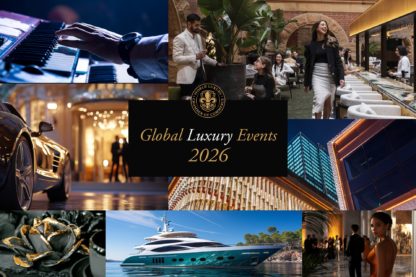Luxury has always been a world of contrasts—timeless craftsmanship meets cutting-edge innovation, exclusivity meets digital accessibility, and tradition meets transformation. Navigating these tensions is no easy feat, but few understand this challenge better than Gabriella Lojacono.
In this exclusive conversation, conducted by Alexander Chetchikov, President of the World Luxury Chamber of Commerce, Gabriella shares insights from her book Resilience of Luxury Companies in Times of Change and her extensive experience at SDA Bocconi. From balancing heritage with reinvention to the impact of AI, sustainability, and the metaverse, this interview takes a deep dive into what luxury brands must do to thrive in an era of rapid change.
Alexander Chetchikov: Gabriella, your book Resilience of Luxury Companies in Times of Change explores the importance of ambidexterity in luxury brands. What are the key strategies luxury companies must adopt today to balance innovation and heritage?
Gabriella Lojacono: The challenge for luxury brands today is not about choosing between exploiting their core competencies—such as heritage, craftsmanship, and archives—or exploring new trajectories. Instead, they must master both. The latter, however, is far more difficult.
A key enabler for balancing innovation and heritage is having a clear and well-defined purpose and values, which act as a strategic compass for decision-making. When both internal teams and external stakeholders are aligned with these foundational elements, brands can innovate while remaining authentic to their legacy.
However, innovation within a large, established luxury house is complex. Giants in the industry often struggle with agility due to their scale and deeply rooted structures. The most effective strategies to foster innovation include:
1. Creating internal incubators → Establishing dedicated units separate from daily operations allows for experimentation and risk-taking, without disrupting the brand’s core business.
2. Acquiring small, high-potential brands → Investing in emerging players helps inject fresh creativity, new consumer engagement models, and digital-first mindsets into the company while expanding into new market segments.
Ultimately, ambidexterity in luxury is about embracing structured duality—safeguarding the past while proactively shaping the future
AC: Luxury brands have traditionally relied on exclusivity and craftsmanship, but digitalization has reshaped the landscape. How can luxury houses maintain their aura of exclusivity while embracing e-commerce and social media?
GL: Digital transformation in luxury is not just about e-commerce and social media—it is about leveraging technology to enhance, rather than dilute, the core values of exclusivity and craftsmanship. The most significant shift today is the integration of AI and advanced data analytics, which can reinforce traditional luxury principles rather than replace them.
Luxury is fundamentally about personalization, storytelling, and rarity. AI-driven tools can augment these elements by:
1. Crafting hyper-personalized experiences → Beyond product recommendations, AI enables luxury brands to create tailored services, bespoke designs, and customized client interactions, reinforcing the idea of exclusivity, moving from Clienteling one to many, to one to one
2. Enhancing craftsmanship through innovation → Digital tools like virtual ateliers, augmented reality fittings, and blockchain for provenance tracking help preserve heritage while adding layers of transparency and engagement.
Ultimately, digitalization should be seen as a strategic enabler, not a threat. By integrating AI and other technologies in a way that aligns with luxury’s essence, brands can offer next-level personalization while maintaining their aura of rarity and desirability.
AC: Sustainability is a pressing issue in luxury, with growing consumer demand for ethical production. From your research, how can luxury companies integrate sustainability into their business models without compromising their core identity?
GL: Sustainability is no longer a choice but a fundamental expectation in the luxury industry. Today, it is taken for granted that luxury brands must address key issues such as carbon footprint reduction, supply chain preservation, and diversity, equity, and inclusion (DEI)—all of which are now top priorities on the strategic agendas of luxury CEOs.
One of the most significant industry-wide efforts is Aura Blockchain, a consortium involving major luxury houses to ensure transparency and traceability across the supply chain. This technology guarantees ethical sourcing, authenticity, and sustainability credentials, reinforcing trust without compromising exclusivity.
Beyond traceability, brands like Loro Piana have integrated sustainability into consumer engagement by linking blockchain insights with CRM platforms and dedicated apps. This allows clients to access detailed information about the provenance of materials and ethical production processes, further enhancing brand storytelling and perceived value.
Ultimately, integrating sustainability into luxury is not about compromise—it is about reinforcing craftsmanship, authenticity, and long-term brand equity while meeting the evolving expectations of discerning consumers
AC: Many luxury brands have faced challenges with inventory management and overproduction. What creative business models have you seen emerge to address these challenges, and which brands are leading the way?
GL: Inventory management and overproduction have long been challenges for luxury brands, often leading to markdowns or unsold stock that risks diluting exclusivity. One of the most effective emerging business models to address this issue is the pre-order model, which enhances both sustainability and operational efficiency.
By producing only the quantity requested—often with a minimum batch threshold—brands can reduce waste, optimize resources, and maintain the scarcity that defines luxury. This approach also strengthens customer engagement, as clients become active participants in the production process, fostering a sense of exclusivity and anticipation.
However, the pre-order model requires significant flexibility in the supply chain, particularly in terms of agile production, supplier coordination, and real-time demand forecasting.
Additionally, made-to-order and capsule collection strategies are being used to further refine inventory planning, ensuring that production aligns closely with actual demand.
AC: You direct the Executive Master in Luxury Management (EMiLUX) at SDA Bocconi. What unique elements does the program offer to professionals looking to thrive in the luxury sector?
GL: The Executive Master in Luxury Management (EMiLUX) at SDA Bocconi is a truly international and immersive program, designed for professionals looking to thrive in the luxury sector. What sets EMiLUX apart is its global approach, as our participants—who come from all over the world—travel across key luxury hubs to experience firsthand the business dynamics and cultural nuances of different geographies.
A defining feature of the program is our strong industry partnerships, particularly with Cartier, which has been on board since the very first module in Paris. Participants engage with leading luxury brands through real-world challenges, gaining direct exposure to strategic decision-making and brand innovation.
Additionally, we ensure a hands-on experience—our candidates spend an entire day in luxury retail stores or five-star hotels, observing and analyzing key operational and customer experience processes.
And when it comes to understanding digital transformation in luxury, what better place to learn than Silicon Valley? Our program takes participants to the heart of technological innovation, helping them grasp how AI, e-commerce, and data-driven strategies are reshaping the luxury industry.
AC: Made in Italy is a globally recognized mark of excellence. In your experience, what are the biggest challenges and opportunities for Italian luxury brands competing on the international stage?
GL: Made in Italy is synonymous with excellence, craftsmanship, and creativity, giving Italian luxury brands a strong competitive edge globally. However, despite these strengths, the industry faces both challenges and opportunities in today’s evolving landscape. The current geopolitical and economic instability has created significant disruptions, impacting raw material availability, production timelines, and costs. This is particularly critical for luxury, where craftsmanship and quality control are non-negotiable.
Many Italian brands are experiencing stagnation in mature markets, forcing them to rethink their expansion strategies and customer engagement models.
While Italian brands excel in creativity and craftsmanship, they often lag behind global competitors in brand storytelling, digital engagement, and long-term brand management strategies—key elements for building lasting consumer relationships.
AC: The metaverse is becoming a new frontier for luxury. Given your work on the course Competing in the Metaverse, how do you see luxury brands leveraging virtual spaces to enhance their brand presence and engage consumers?
GL: The metaverse represents a powerful new frontier for luxury brands, but its true potential lies in being seamlessly integrated into a holistic retail experience—one that connects online and offline touchpoints rather than existing in isolation.
Luxury has always been about exclusivity, storytelling, and deep emotional engagement, elements that can sometimes be lost in traditional e-commerce. The metaverse augments the digital experience by introducing new layers of immersion, personalization, and interactivity, helping to bridge the gap between high-touch physical retail and the convenience of digital channels.
AC: With your extensive research and experience at SDA Bocconi, what advice would you give to aspiring professionals who want to build successful careers in the luxury industry?
GL: The luxury industry is evolving rapidly, and for aspiring professionals, success is not just about passion for the sector—it requires a combination of strong expertise, adaptability, and strategic thinking. Based on my experience at SDA Bocconi, my key advice would be:
1. Stay True to Your Competencies and Leverage Them Strategically
- The luxury industry values specialized skills and deep expertise, whether in digitization, CRM, operations, trade marketing, merchandising, or retail.
- Don’t simply try to fit into the industry; instead, find a way to add value through your unique capabilities.
2. Be Prepared for Change Management
- Luxury is facing unprecedented transformation, with new executive appointments and new consumer expectations.
- Those who succeed are not just creative or strategic thinkers, but also change agents—professionals who can navigate uncertainty, adapt to new trends, and drive transformation within established brands.
As the conversation with Gabriella Lojacono wraps up, one thing is clear—luxury isn’t just about what’s been, but what’s next. In an industry where legacy and innovation must go hand in hand, the brands that will succeed are the ones that embrace change without losing their soul.
From digital transformation to sustainability, from new business models to the power of storytelling, Gabriella’s insights illuminate the path forward for both established houses and the next generation of luxury leaders.
A special thank you to Gabriella for sharing her expertise, and to Alexander Chetchikov for leading this fascinating discussion. Luxury is evolving, and with voices like these guiding the way, its future has never looked brighter.
To read more inspiring interviews, visit https://worldluxurychamber.com/insights-news/
Visit SDA Bocconi to learn about their courses, and get Garbiella’s book on Amazon.





